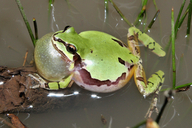|
Hyla wrightorum Taylor, 1939
Arizona Treefrog, Wright's Mountain Tree Frog Subgenus: Dryophytes | family: Hylidae subfamily: Hylinae genus: Hyla |
|
Taxonomic Notes: Duellman et al. (Zootaxa 2016) treated two major clades as genera; AmphibiaWeb treats these two clades as subgenera(Hyla in the Old World; Dryophytes in the New World and East Asia), thus stabilizing traditional taxonomy. |
|
 © 2022 William Flaxington (1 of 18) |
|
|
|
Description It is similar to H. eximia in appearance, though it is larger in size, has longer legs, a wider and less pointed head, a relatively longer first finger, a darker lower jaw, and a lighter colored thigh. Additionally, H. wrightorum has a shorter, higher frequency call than H. eximia (Taylor 1938). In life, it has a bright green back, with a dark line running down the sides from the nostril, to the eye and tympanum, and sometimes even down to the groin, that may be broken up into smaller sections. The underside is golden and orange, with a slight hint of green. There are uneven dark brown spots and stripes on the arms, legs, and back, as well as dark stripes on the legs and upper arms. The iris is a metallic brown color. In preservative, the backside is gray and lavender in color. The line running down each side is brown, as are the spots and stripes on the back and the limbs. The underside is white, with faint pigmentation on the chin, throat, and the underside of the limbs. The upper legs and groin show some slight brown pigmentation (Wright and Wright 1933, Taylor 1938, Duellman 1970). The dark spots on the back are highly variable between individuals. Additionally, the dark line running down the sides is broken up differently between individuals (Wright and Wright 1933, Taylor 1938, Duellman 1970). Distribution and Habitat Country distribution from AmphibiaWeb's database: Mexico, United States U.S. state distribution from AmphibiaWeb's database: Arizona, New Mexico
Life History, Abundance, Activity, and Special Behaviors Trends and Threats Possible reasons for amphibian decline General habitat alteration and loss Comments It is part of the H. eximia species complex. Taylor originally described it as a separate species from H. eximia in 1938, before being reassigned as a subspecies of H. eximia in 1953 by Schmidt, and subsequently as a subspecies of Pseudacris regilla in 1966 by Jameson et al. In 1977, Renaud suggested that H. wrightorum is indeed its own separate species, which was later confirmed in 2001 by Duellman (Sullivan 1986, Gergus et al. 2004, Hammerson 2004). The specific epithet, wrightorum, is named after American herpetologists Anna Allen Wright and Albert Hazen Wright (Taylor 1938). The existence of two disjoint populations, one extending from central Arizona into central western New Mexico, and the other from southern Arizona to Mexico, has led to measurable genetic variation between allopatric individuals. However, it is not enough to fully elevate either population to its own species, suggesting the populations were separated relatively recently (Gergus et al. 2004).
References
Duellman, W.E. (1970). The Hylid Frogs of Middle America. Monograph of the Museum of Natural History, University of Kansas. Gergus, E. W., Reeder, T. W., Sullivan, B. K. (2004). ''Geographic variation in Hyla wrightorum: Advertisement calls, allozymes, mtDNA, and morphology.'' Copeia, 4, 758-769. Hammerson, G. (2004). Hyla wrightorum. The IUCN Red List of Threatened Species. Version 2015.2. www.iucnredlist.org. Downloaded on 19 August 2015. Sullivan, B. K. (1986). ''Advertisement call variation in the Arizona tree frog, Hyla wrightorum Taylor, 1938.'' Great Basin Naturalist, 46(2), 378-381. Taylor, E. H. (1938). ''Frogs of the Hyla eximia group in Mexico, with descriptions of two new species.'' University of Kansas Science Bulletin, 25(19), 421-445. Wright, A. H. and Wright, A. A. (1949). Handbook of Frogs and Toads of the United States and Canada. Comstock Publishing Company, Inc., Ithaca, New York. Originally submitted by: Jacobo Conde, Gordon Lau (first posted 2011-06-24) Edited by: Ann T. Chang (2019-12-12) Species Account Citation: AmphibiaWeb 2019 Hyla wrightorum: Arizona Treefrog <https://amphibiaweb.org/species/6125> University of California, Berkeley, CA, USA. Accessed May 22, 2025.
Feedback or comments about this page.
Citation: AmphibiaWeb. 2025. <https://amphibiaweb.org> University of California, Berkeley, CA, USA. Accessed 22 May 2025. AmphibiaWeb's policy on data use. |



 Map of Life
Map of Life